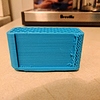Hey Everyone,
I am a total noob at this, but I thought someone with more experience might be able to point me in the correct direction. I am using a Wanhao Duplicator i3, for the most parts I have been really happy with how my prints have been coming out. A friend asked me to print this Beer tap handle(Card holding tap handle by galway - Thingiverse).
I printed it upright (In the same direction as the picture) but as you can see on the right side of the print it is seriously under extruded. The rest of it looks really good though, so I am confused what could be causing this on the one side.
Temp 220
Infil 20%
Layer Height .1
print speed 30 mm/s
If anyone can point me in the right direction that would be great! as I said I am super new to this but I want to learn!
1 Like
You have to level your z axis first, so the left and right axis are on the same height. There are tools to print to help you with. Second your bed must be leveled. This looks certainly a misleveling
1 Like
Hi, run that .stl file through Netfabb basic and check for errors, it could be a design flaw. Netfabb basic is a free software. Once downloaded open up the file,if you see a red rectangle with quotation mark, this indicates an error on file. Netfabb basic will repair it for you. For more guidance on Netfabb basic research YouTube.
1 Like
I’m not entirely sure that’s under-extrusion. What does the rest of the right side look like? If it were under-extrusion I’d expect the whole right side to look bad, but the top after the corner looks fine from the photo. To me it looks more like it started printing on thin air and globbed up. Then it just kept doing the same thing from the start of it onwards. Also, you might try printing at .2 or .25 instead of .1.
Thanks, you bring up a good point the majority of the right side is fine just the corner. I have printed one at .2 and I ran into the same issue.
Something to think about.
Wow that is incredibly helpful!
Thank you,
I doesn’t seem to be under-extrusion… check the mesh for errors with some free software. I don’t think is a level issue or a bad screwed z axis, but to be sure check that as well.
hope that helps.
I was kind of thinking that (Based on some reading I have been doing). I did level the bed when I got it, but since I am a newbie I might not have done a great job with it. I haven’t checked the Z axis at all. I will do that right away.
Thanks for your reply!
I opened the file, with cura and repetier host, it looks fine to me. The Gcode generated looks fine. Then I opened it with MODO 102, and it doesn’t have any issues, so the file is OK.
Then I noticed the first layers of your print… and it looks like they printed in thin air. So I guess I should try to print it with some good support first. Maybe try repetier.
Also you may want to try to rotate the print so it prints in the y axis lenght instead of the x axis… and maybe you have better results that way. Also chech that the Z axis couples are secured tight and at the same level.
Or you may want to try printing it flat with supports for the opening in the top ( flat side down, not like it came originally ).
Another thing… just for you to check your printer, you can cut off the object like 1 cm ( advanced settings cura ) and then start a test print so you can see if it continues to do the same thing.
What material is this? Temp is kind of high for PLA and a bit low for ABS.
Hard to say exactly. If your .stl file checks out, then I would look at your settings, layer height, top and bottom layers, wall thickness, infill etc, etc, you are running 30 mms speed, which should give you a good quality print. Look for basic settings that may have been changed by accident. Filament size, nozzle size etc…reposition file in different area of bed and reprint. I assume at that speed, that size file is taking approx. 2.49 hrs. Worth trying a reprint
One more advice
take and increase your layer height to 1.2, increase to top and bottom layers to 1.6, and you wall thickness to 1.2 as well. By increasing those values you are giving more strength to the part. Though I think your intent was more of quality. The problem with such small values is strength and support. The bottom and top layer help hold the infill together and the wall keeps part intact. If you run a low first layer and let’s say you are using glass and hairspray, when you go prying the part out of the bed that first layer may not come out with the piece you are printing. So yeah experiment with those values. And Noob or not everyone has been and worn those boots. Keep on trying
This is also very helpful. I appreciate it!
It is standard PLA. What temperature do you recommend?
I didn’t even know about that setting, thanks!
How much retraction are you using?
Also, what retraction speed are you using?
190-210 depending on the brand but that should be a fairly safe range.
Try rotating or re-orienting the part on the print bed and see if the bad area follows the part or stay in the same location to the machine.
What slicer are you using?
